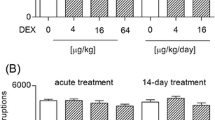Abstract
Although antidepressant administration has been reported to alter the pituitary–adrenal (PA) axis, the results are puzzling. In the present work, two possible factors contributing to these contradictory results were studied in adult male Sprague–Dawley rats: (i) the type of antidepressant and (ii) the time of day at which samples were taken. Samples were taken under nonstressful conditions. In expt 1, the acute effects of two doses (10 and 20 mg/kg) of the tricyclics clomipramine (CMI), desipramine (DMI) and imipramine (IMI), and the non-specific monoamine oxidase inhibitor (MAOI) phenelzine were studied. Only phenelzine increased plasma corticosterone with the low dose, whereas phenelzine and DMI increased plasma corticosterone with the high doses when measured 30 min after drug administration. In a second experiment, it was observed that after 12 daily doses of the drugs (20 mg/kg), all drugs increased plasma corticosterone at 30 min after the last drug administration. When the circadian pattern of corticosterone was studied in the same experiment, starting on the day after the last drug administration, a significant interaction of drug by time of day was found. Drugs caused changes in the normal levels of plasma corticosterone at certain times and DMI, IMI and phenelzine reduced the number of rats showing the normal corticosterone peak at 1900 hours. No significant effect of drugs on corticosteroid-binding globulin (CBG) was found. In a third experiment, phenelzine and IMI were administered as before, but samples were taken at several times both on the day of the last drug administration and on the following day. The two drugs altered the normal circadian pattern of corticosterone in a somewhat different way, but both caused a reduction of the corticosterone peak at lights off on the day after the last drug administration. The normal relative thymus weight observed in all groups (exp. 2) suggests that the overall biological activity of corticosterone was probably not affected by antidepressants. The present results indicate that most antidepressants are able acutely to activate the PA axis after repeated administration in a similar way or even morestrongly than after the first administration, and that some of these drugs alter normal circadian pattern of corticosterone. No evidence for decreased resting PA activity was found in antidepressant-treated rats.
Similar content being viewed by others
Author information
Authors and Affiliations
Additional information
Received: 6 June 1997/Final version: 11 April 1998
Rights and permissions
About this article
Cite this article
Gómez, F., Graugés, P., Martín, M. et al. The effect of chronic administration of antidepressants on the circadian pattern of corticosterone in the rat. Psychopharmacology 140, 127–134 (1998). https://doi.org/10.1007/s002130050749
Issue Date:
DOI: https://doi.org/10.1007/s002130050749




